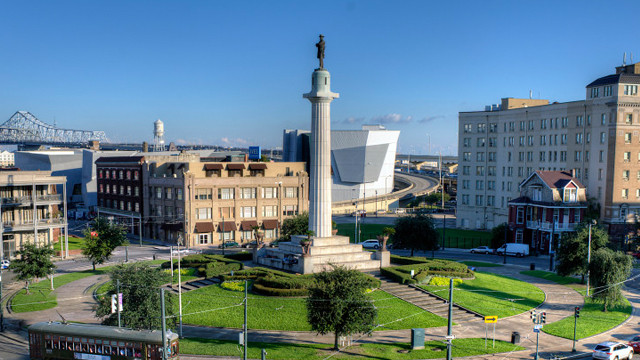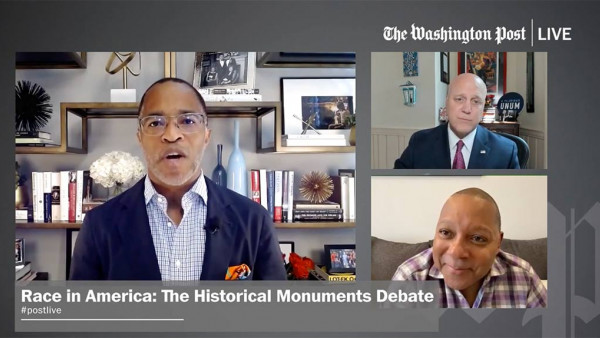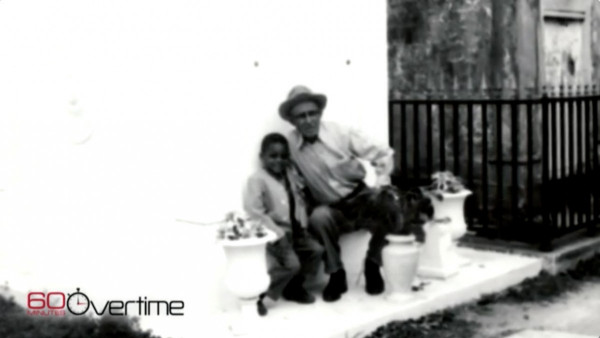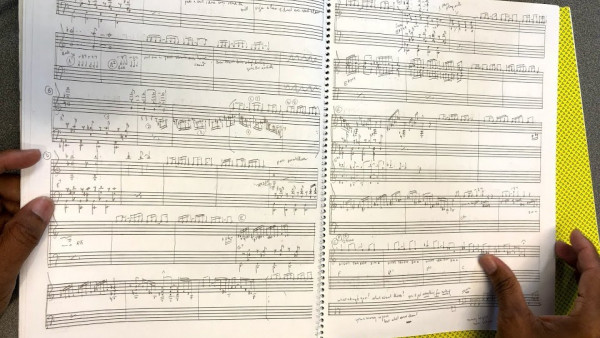Take Robert E. Lee’s statue down and rename the Circle

General Robert E. Lee Circle in New Orleans
In October of 2005, after Hurricane Katrina devastated New Orleans, then Lieutenant Governor Mitch Landrieu and I appeared before the U.S. House joint committees of Transportation and Infrastructure to make a plea for what was needed to rebuild our city. Mitch is a fellow trumpet player and champion of healing our city through the arts. We first met in high school through some type of band program or music competition. His father, “Moon”, had been a transitional mayor for the city, challenging segregation and many of the ante-bellum perspectives that kept us mired in 19th century social practices and attitudes.
At that Congressional hearing, Mitch opened up with a roll call of about 20 names. It seemed like a strange way to begin, so I thought perhaps it was a list of prominent citizens who had perished in the storm. He finished with a statement that went something like,“This is a partial list of the members of THIS body who are currently under indictment, so don’t tell me anything about corrupt Louisiana politicians.” I could only look at him and chuckle to myself at his nerve thinking wow! this is an interesting way to ASK for some money.
We’ve laughed about that many times since, and he is now the mayor of New Orleans. For a couple of years, we have spoken about removing Confederate General Robert E Lee’s statue. My initial desire to see this done is not connected to the current wave of requests for adjustments in our public symbology. It goes back to childhood when I discovered what Lee had done and what he represented. This Thursday, the city council has a vote on taking down this monument and renaming the circle in the middle of the city. I am not a fan of using today’s morality and standards to rename every building and statue of conquerors and people of great achievement because they weren’t also saints. This however, is a different case. Mitch asked me and I offered to write a contributing op-ed for nola.com /the Times Picayune on this issue.
This is a lengthier unedited version of what is already online and will appear in the paper today.
Why New Orleans should take down Robert E. Lee’s statue
“Man, you must be crazy!” (Replied a customer in a Pigeon Town barber shop in 2010 to the suggestion that we should erect a statue in front of the Superdome honoring the Super Bowl’s losing Indianapolis Colts coach, Jim Caldwell, instead of the victorious Sean Payton, coach of our New Orleans Saints, because some people in town had really really wanted the Colts to win).
That sensible customer clearly understood the meaning and purpose of public symbols.
Our national myths and symbols tell us who we are, who we have been, and who we want to be. All across America there are symbols that commemorate victories and defeats, that evoke despair over tragedies, and elicit joy over triumphs. Some markers celebrate courage in the face of adversity, while others painfully remind us of what must never occur again. Regardless of how, when and why they were erected, all are expressions of our cultural mythology and reflect some portion of a larger national truth. The most important of these symbols represent values that should be considered and reconsidered by every generation as part of its civic duty. They are the sirens of our conscience, and the building blocks of our consciousness.
Our Constitution is a plan, a process, and a symbol. Designed to accommodate the necessity for change with the passage of time and of custom, it can be amended. The flexibility of this most sacred text is considered to be the ultimate proof of the genius and long-range vision of our Founding Fathers. Belief in change is at the heart of our democratic story. We adapt, we improvise, and we course-correct through argument and compromise, ideally in attempting to form ‘a more perfect union’.
I once asked my father if he had any idea, back when he was 22 years old in 1956, that segregation would be illegal within ten years. He said, “I couldn’t see it even after King was on the scene. And when Lyndon Johnson, a Southerner from Texas, became President, I thought, the game is definitely up.” Johnson would in fact go on to expend a large portion of his political capital leading America to pursue and achieve legal social equality for the American Negro. We are capable of sudden and profound change.
President Johnson understood that national stories and symbols need to be amended, and that the moral imperatives that support human dignity have to be honored at the speed of now. In the words of Dr. Martin Luther King Jr. in a 1964 address to the students at Oberlin College,“The time is always right to do what’s right.” Whether it is a person, city or country, there are always aspects of personality that can and should be improved. There can be as much benefit in tearing down things of little worth as there is in constructing things of great value.
For all there is to love about New Orleans, a pervasive racism and inequality has plagued our civic life from the earliest days. This foul condition forced our greatest ambassador, Louis Armstrong, to choose not to be buried in this home that he cherished and glorified night after night before a world audience. He was hurt to the bone by what he’d seen and experienced here. And though he represented our city the place of magic, mystery and good times that it is, he also lived our shameful legacy of social injustice and racism. In 2015, that tradition is no longer a skeleton in our closet: it’s a whole cemetery. Now is the perfect time to remove the head tombstone.
Take Robert E. Lee’s statue down from its place of honor overlooking our city and rename and repurpose the circle that bears his name.
When one surveys a few of our local heroes from Iberville and Bienville, to Andrew Jackson, Homer Plessy and Mahalia Jackson, on to Andrew Young, Anne Rice and Wendell Pierce, to Harry Connick, Jr., John Besh and Jonathan Batiste, they are left to ask, what did Robert E. Lee do to merit his distinguished position? He fought for the enslavement of a people against our national army fighting for their freedom; killed more Americans than any opposing general in history; made no attempt to defend or protect this city; and even more absurdly, he never even set foot in Louisiana. In the heart of the most progressive and creative cultural city in America, why should we continue to commemorate this legacy? Whether viewed through the prism of his time or ours, he is wholly and unreservedly undeserving of this honor.
When I was 15, I traveled to Greensboro, North Carolina for summer music camp. In answering the common question, “where are you from?” with “New Orleans,” the response was always some type of verbal affirmation of our national status. “Yeah! Great music, food, Mardi Gras, and (during that period) are the Saints ever going to win?” To be from New Orleans was to be cool. People would gush and go on to ask many questions about our way of life. I was always proud to answer what I could and brag about our city. Even now, I love just saying the name of our hometown and will recite all of our nicknames in a long roll call if you don’t stop me.
I never feel compelled to tell non-natives about the true racism that I experienced growing up here. It’s hard to explain, and people from other places aren’t interested in hearing all of that when they really just want to talk about gumbo and find a good place to hear some live music. Don’t get me wrong, I love talking about po’ boys and recommending exciting night spots, but all the Crescent City ‘fun’ in the world can’t cover up the damage inflicted on our city and way of life by the lingering Confederate aspirations that still pollute a portion of our dreams, still influence our decision-making, and ultimately prevent us from joining the modern world, let alone defining it. The destructive effects of this legacy are evidenced by gross inequalities in everything from education to housing, to employment and access. We live it and are accustomed to it, but we are also capable of so much more. It’s time to live up to our potential, not down to the flaws that we have inherited.
The support we received after Hurricane Katrina was an undeniable demonstration of the love and respect that people around the world have for our culture. But even in the midst of this overflowing good feeling and care, I would often get candid questions, “What happened to all the jazz on Bourbon Street?” “Why is it so commercial?” or “What’s up with your schools down there?” and of course, “Why is there so much crime?”
Yes, murder, corruption, and ethnic mayhem are real, present and persistent tragedies always in the headlines at home and around the nation. They are always a part of movies, TV shows and musical talking over computerized tracks that sometimes function as social commentary, but most times strive to reinforce minstrel era stereotypes that replace the plantation with the “hood”, and shuffling, grinning and acting stupid with misogyny, scowling and celebrating transgressions against other black people. The din of popular products aside, a deeper, more everlasting crime is being committed and celebrated every day in full public view, and with very little, if any, mythologizing in the arts or the media. We maintain a stubborn tradition of entrenched segregation and generational prejudice that has prevented the development of a rich, diverse social and business environment that should have naturally evolved from our hybrid culture and unique brand of unforced cross-cultural creativity. This odious heritage smolders with white-hot heat in the aftermath of 350 years of the darkest crimes against humanity; a carnival of injustices carefully concealed by the counterfeit construct of race.
Non-New Orleanians have no idea that when the Americans took over the city after the Louisiana Purchase, they proved far less progressive than the Spanish and French who had preceded them. With ordinance after ordinance accompanied by constant aggravation, New Orleans’ city fathers made sure that the treatment of slaves and non-white Creoles worsened with each passing year and eventually even succeeded in shutting down the music and dancing that had once filled Congo Square. Long after the Civil War had been decided in favor of the winners – us—this same kind of leadership erected monuments to Confederate Generals who had committed treason against the United States and lost.
And today, the descendants of these repressive anti-freedom efforts still fight under the banner of “our Southern heritage.” Well, we have the most diverse heritage of any city in this country. Let that diversity identify us instead of some arcane hope of continuing to make Confederate aspirations seem noble. They weren’t then, and they aren’t now.
It’s time for us to actually embrace, live up to, and educate our kids about the best of our cultural legacy and put this foolishness in its proper place. Robert E. Lee betrayed his sacred oath to support and defend the Constitution and instead chose to lead an army intent on its violent overthrow—-and he lost.
There was a natural arrogance that attended the type of hubris that led some to feel that the cause of enslavement should be the law of the land, in a nation founded on the credo of freedom. This monument was originally erected to proclaim this arrogance across the ages and to claim a victory that was unearned on the battlefield. It’s time for this age to answer with unapologetic clarity on the absolute wrongness of their cause.
After Hurricane Katrina, the support we received from people all over the world clearly demonstrated an appreciation of our culture and our character. The quality and depth of this love was demonstrated with unprecedented assistance of all kinds. When we consider the intensity with which everyone embraced our culture, and the speed of technological advances that have resulted in even more global connectivity and integration, it’s impossible to justify a monument (with mound) in the middle of our city meant to glorify a losing general who fought against our country, against freedom and against the maximizing of our human potential through integrated creativity.
The world is getting closer and closer. That is the future. We should step into it and transform Lee Circle into a sanctified space that celebrates the communal intentions of the so-many-people who helped us survive Katrina. It would fill the heart of our city with something uplifting for all of us, and for all times. This should be the mythology we strive to teach to our kids and leave for our descendants, not the stubborn echo of a corrosive period of our history.
Wynton





Comments
Thank you for this post. I am a mother of 6 children. 2 of them have pined for brass instruments for a few years. Like myself, they love to listen to Louis and you and your family. They have read books, articles, and listened. We finally saved enough to get the student sax and trumpet and they are overjoyed. The new instruments caused us to go to your blog. Thank you for your words here. They are powerful and good and right. 6 in our family are caucasion and two are dark skinned and from Haiti. We have experienced racism for sure and for us it has come from people of every shade dermatologicaly speaking. One thing I know is that my children are all beautiful and have amazing potential and when others try to do harm to them or speak hate to them, they will contend with me and their Daddy. Love triumphs hate and mercy triumphs judgement. But, we, with you will not choose to honor those who chose to fight for injustice and human atrocities, and hate. Someday we will save enough and hopefully take our 8 to see you! Thank you!
Crystal smith on Dec 20th, 2015 at 11:46am
Excellent article! As a lover of history and the things that connect us to that history, I must admit a bit of nostalgic winsomeness at the thought of possibly not seeing those monuments in our cityscape. However, the the points you make far outshadow that thought.
Again, excellent job.
Dr Robert J Graziano on Dec 17th, 2015 at 10:18am